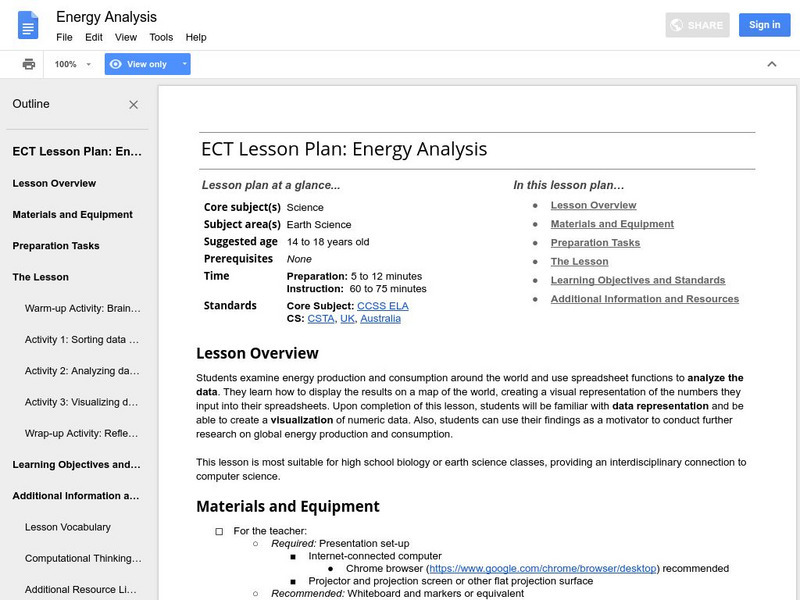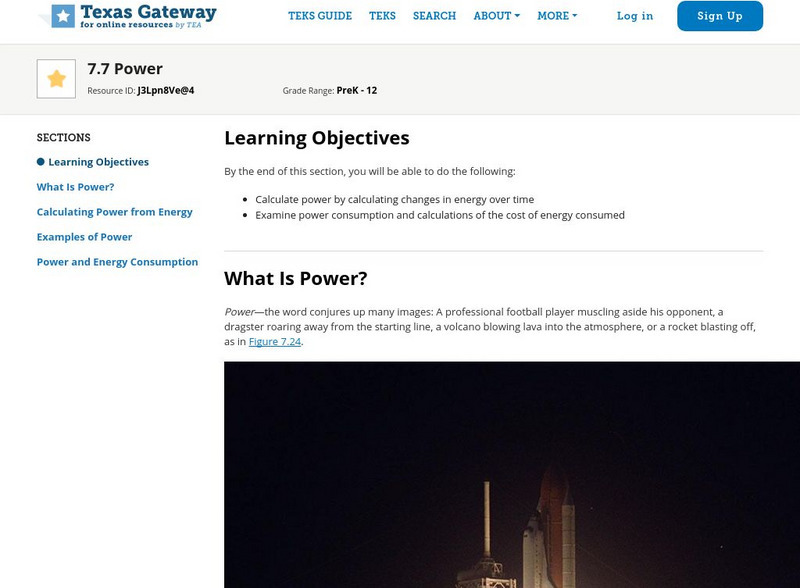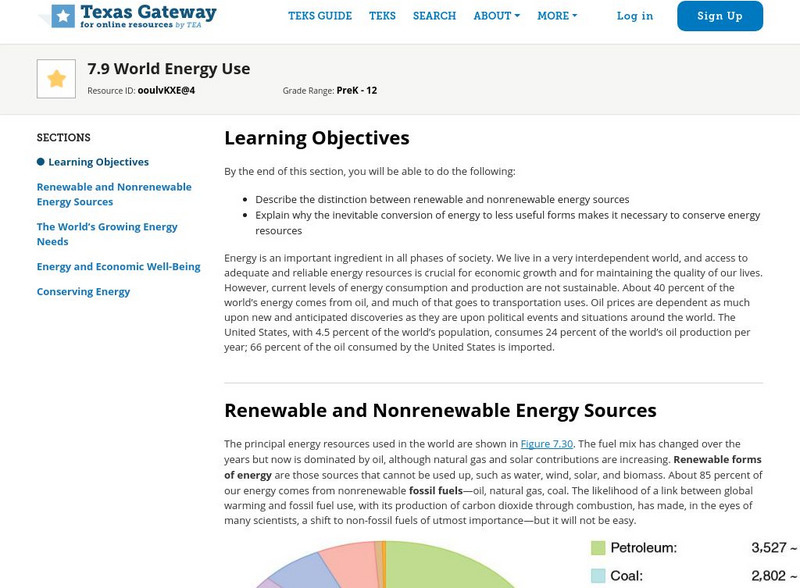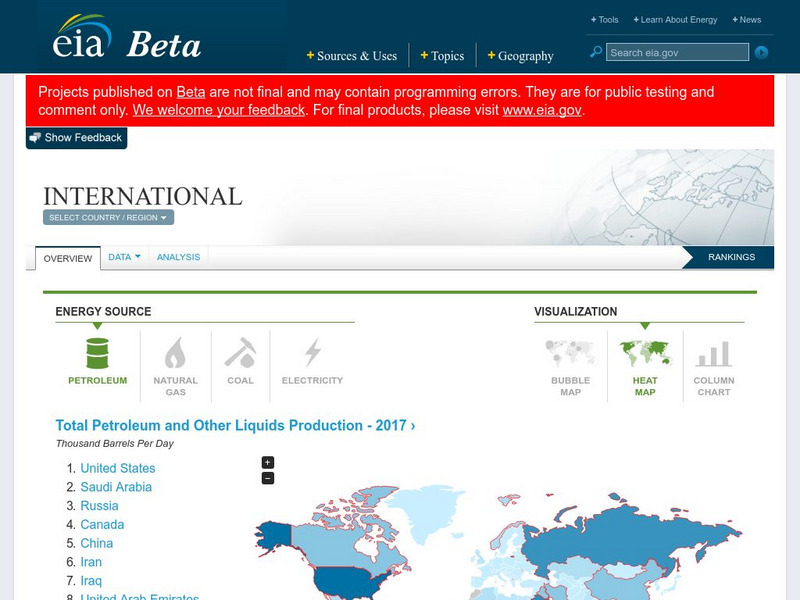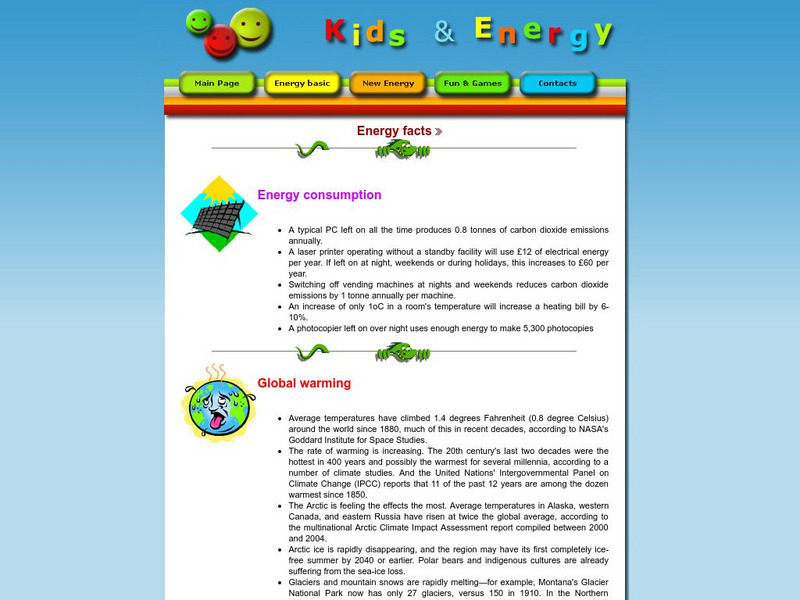National Geographic
National Geographic: Energy Efficiency
After an examination of data on energy consumption in the United States, students suggest alternative ways to meet our electricity needs, and how to increase energy efficiency. Includes online student exercises and a teacher answer key,...
Georgia Department of Education
Ga Virtual Learning: Ap Environmental Science: Energy Use and Energy Sources
This interactive learning module will focus on the fundamentals of energy and energy sources, renewable and nonrenewable, that support the human population. Students will also explore our dependence on nonrenewable fossil fuels to...
TeachEngineering
Teach Engineering: Energy Perspectives
Students utilize data tables culled from the US DOE Energy Information Agency to create graphs that illustrate what types of energy we use and how we use it. An MS Excel workbook with several spreadsheets of data is provided. Students...
Google
Google for Education: Energy Analysis
Students collect data on energy production and consumption around the world. They input the data into a spreadsheet and use spreadsheet functions to analyze it. Finally, they upload the data into a fusion table to create a visualization.
PBS
Pbs Learning Media: Snapshot of u.s. Energy Use
This video segment adapted from NOVA/FRONTLINE looks at American energy consumption and the resulting production of greenhouse gases. [4:59]
PBS
Pbs Online News Hour Extra: Analyzing Your School?s Energy Consumption
The resource is a lesson plan that compares a school's energy consumption with that of a LEED certified school. In addition, learners identify areas that are within the school's capacity of change and audit the school?s recycling...
Science Education Resource Center at Carleton College
Serc: Should I Unplug?
Students will have a heightened awareness of the amount of energy they waste after they complete this activity. They will learn about plug loads, and use a wattage meter to measure the plug loads of various devices, as well as calculate...
Science Buddies
Science Buddies: He Huffed, and He Puffed, but Didn't Blow the House Down!
In the fairy tale of the three little pigs, the wolf huffed and puffed and blew down the first pig's straw house. But in reality, straw tied into bales is a viable building material that when used properly, makes sturdy and...
National Academies of Sciences, Engineering, and Medicine
The National Academies: How We Use Energy
The main categories of our energy use - home, work, transportation and industry - are examined to see how much energy we are using and what can be predicted about our use in the furture.
US Energy Information Administration
Energy Information Association: u.s. Household Electricity Report
The report provides an overview of the electricity consumption in households in 2001. End-use (lighting, appliances, heating) data is presented in written, graph and table form. Background on efficiency standards and regional factors...
OpenStax
Open Stax: Work, Energy, and Power in Humans
In the following interactive students will begin to explain the human body's consumption of energy when at rest vs. when engaged in activities that do useful work. They will also calculate the conversion of chemical energy in food into...
Other
American Coal Foundation: Lesson Plan: Conserving Electric Energy
Lesson plan focuses on electricity use and energy consumption, while engaging students in a hands-on activity that helps them comprehend the effects of regulation and conserving energy resources.
Texas Education Agency
Texas Gateway: Ap Physics: Power
By the end of this section, you will be able to calculate power by calculating changes in energy over time and to examine power consumption and calculations of the cost of energy consumed.
Texas Education Agency
Texas Gateway: Ap Physics: World Energy Use
By the end of this section, you will be able to describe the distinction between renewable and nonrenewable energy sources and to explain why the inevitable conversion of energy to less useful forms makes it necessary to conserve energy...
Other
Alliance to Save Energy: A Home Energy Audit
This activity allows learners to become building inspectors, identifying features that can help or hurt energy conservation.
PBS
Pbs Learning Media: Global Warming: Beyond Fossil Fuels
Martin Hoffert, professor of physics at New York University, discusses global warming and alternative energies in this interview from the NOVA/FRONTLINE: "What's Up with the Weather?"
State Energy Conservation Office-Texas
State Energy Conservation Office: Renewable Energy for the Home [Pdf]
Discusses different ways to heat and cool a home, and perform a variety of tasks, using renewable energy sources. Examples include window shades, a solar water heater, solar-powered toys, etc.
State Energy Conservation Office-Texas
State Energy Conservation Office: Using Energy Wisely [Pdf]
The importance of energy conservation and energy efficiency are discussed, with reference to where Americans' energy use compares to that of the rest of the world.
University Corporation for Atmospheric Research
Ucar: Energy Choices and Climate Change
Help the Joules family make choices that keep their greenhouse gas emissions low.
University Corporation for Atmospheric Research
Ucar: Plugged in to Co2
Students analyze the energy consumption of a household appliance and estimate the amount of carbon dioxide it is adding to the atmosphere each year.
Energy for Sustainable Development
Esd Bulgaria: Kids & Energy: Save Energy
Looks at four different ways people can save energy - through energy efficiency, recycling, planting trees, and protecting wildlife.
USA Today
Usa Today: Workers Adjust Habits to Save on Gas Costs
This article focuses on the impact on higher gas costs on workers and companies.
US Energy Information Administration
Energy Information Administration: Country Analysis Brief
Contains briefs with a narrative section, a map showing the country's location, and a section listing pertinent economic and energy data for every country in the world of interest to energy policy makers.
Energy for Sustainable Development
Esd Bulgaria: Kids & Energy: Energy Facts
A collection of facts about energy use broken down into various topic areas, e.g., health impact of fossil fuels, transportation, energy consumption, alternative energies, etc.





